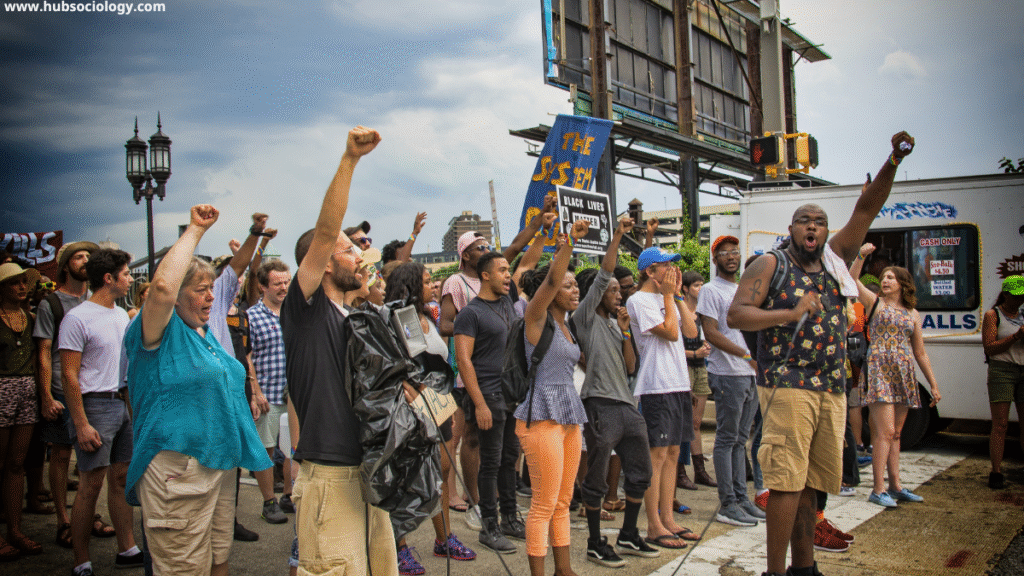Introduction
Social movements are one of the most dynamic forces shaping societies. They reflect collective aspirations, grievances, and struggles of people who seek to bring about social change, resist oppression, or defend existing structures. Unlike everyday social interactions, social movements are organized, sustained, and directed toward particular goals. Sociologists have long studied social movements to understand how societies evolve, adapt, and respond to challenges. In the sociological perspective, social movements are not merely temporary protests; they are a mirror of social tensions, power relations, and cultural transformations.
With an emphasis on their function in social change and group activity, this article examines the definition, characteristics, and forms of social movements from a sociological perspective.

Meaning of Social Movement
Any type of collective activity by a group of people who unite with a shared goal to either support or oppose social change can be characterized as a social movement. According to Herbert Blumer, social movements are “collective enterprises to establish a new order of life.” Similarly, Smelser viewed them as “collective attempts to establish a new social order.”
In simple terms, a social movement is a sustained effort by a section of society to challenge existing norms, values, institutions, or policies, or to create new ones. Unlike short-term riots or spontaneous uprisings, social movements are enduring and based on shared ideology, leadership, and organization.
Thus, in sociology, social movements are not seen as isolated incidents but as indicators of structural strains and catalysts of social transformation.
Features of Social Movement
From a sociological perspective, social movements have distinctive features that set them apart from casual protests or random collective actions. Some of the key features include:
1. Collective Action
Groups, as opposed to lone people, participate in social movements. It is the collective energy and solidarity that gives them strength and recognition in society.
2. Common Objective
Participants in a social movement share a common purpose or ideology. Whether it is the abolition of slavery, women’s rights, or environmental protection, the shared goal unites people across social boundaries.
3. Organized and Sustained
Social movements are more structured and persistent than unplanned events. They involve planned activities such as rallies, strikes, demonstrations, petitions, and campaigns.
4. Social Change Orientation
The fundamental aim of any social movement is to bring about change—whether progressive, regressive, revolutionary, or reformative. Some movements may demand radical restructuring, while others may defend the status quo.
5. Ideological Base
Social movements are often driven by an ideology that provides justification, vision, and direction. For example, the Indian Independence Movement was based on the ideology of nationalism and freedom from colonial rule.
6. Conflict and Opposition
Movements generally emerge in opposition to an existing authority, institution, or dominant culture. Therefore, conflict with the established order is inherent to social movements.
7. Mass Mobilization
The success of a social movement often depends on its ability to mobilize large sections of society through persuasion, media, leadership, and symbols.
8. Dynamic and Evolving
Social movements are not static. They evolve with changing contexts, adopting new strategies, expanding goals, or sometimes declining when objectives are achieved or momentum is lost.
Types of Social Movement
Sociologists have classified social movements in different ways based on their objectives, scope, and methods. The following are the major types:

1. Reform Movements
These movements aim to gradually alter the current political, social, or economic structure. They do not aim to overthrow the structure but to modify it. Examples include the Civil Rights Movement in the USA, the women’s suffrage movement, or the anti-corruption movements.
- Sociological significance: Reform movements reflect dissatisfaction with particular policies or practices without rejecting the entire system.
2. Revolutionary Movements
TThese seek to alter society in a profound, structural, and radical way. The legitimacy of the state or ruling class is frequently questioned by revolutionary movements. Examples include the Russian Revolution of 1917, the Chinese Revolution under Mao Zedong, and anti-colonial struggles in Asia and Africa.
- Sociological significance: Revolutionary movements arise when reform is perceived as insufficient, and masses demand a complete transformation of political and economic structures.
3. Reactionary or Conservative Movements
These movements aim to maintain established institutions, beliefs, and customs while opposing change. For instance, fundamentalist religious movements that oppose modernization or social reforms are examples.
- Sociological significance: Such movements highlight cultural resistance against rapid modernization and globalization.
4. Revivalist Movements
The goal of revivalist movements is to bring back dwindling religious or cultural traditions. Examples include the Brahmo Samaj and Arya Samaj in India, which attempted to reform and revive aspects of Hinduism.
- Sociological significance: Revivalist movements often emerge as a response to colonialism, globalization, or perceived cultural erosion.
5. Reformative Movements (Limited Scope)
Unlike revolutionary movements, reformative movements focus on limited changes in specific areas. For instance, movements against child labor, campaigns for road safety, or anti-smoking campaigns fall under this category.
- Sociological significance: They highlight micro-level reforms within broader systems, addressing specific social problems.
6. Alternative Movements
These movements advocate minor lifestyle changes at the individual level. For example, campaigns promoting vegetarianism, meditation, or eco-friendly lifestyles.
- Sociological significance: Alternative movements reflect the growing influence of lifestyle politics and personal choice in shaping social values.
7. Redemptive Movements
Instead of aiming to change society as a whole, these aim to completely transform individuals. Religious cults, spiritual groups, or movements promoting self-realization and salvation fall into this category.
- Sociological significance: Redemptive movements show how personal transformation is linked to broader cultural and social currents.
8. New Social Movements (NSMs)
Emerging in the late 20th century, NSMs focus on issues beyond class and economic struggles. They highlight identity, environment, gender, peace, and human rights. Examples include the environmental movement, feminist movement, LGBTQ+ rights movement, and anti-nuclear protests.
- Sociological significance: Reflecting the complexity of contemporary cultures, NSMs place a strong emphasis on post-materialist principles, decentralized organization, and global solidarity.
Sociological Importance of Social Movements
From a sociological aspect, social movements serve as engines of social transformation. They:
- Provide a channel for marginalized voices.
- Challenge power hierarchies and inequalities.
- Serve as indicators of social strain and discontent.
- Promote democratization and collective consciousness.
- Shape laws, policies, and cultural norms.
- Act as laboratories for alternative ideas and practices.
Thus, social movements are not merely political tools but also cultural and moral forces that redefine identities and relationships in society.
Conclusion
Social-movements represent the collective will of people to transform society according to their needs, values, and aspirations. Whether they are reformist, revolutionary, conservative, or alternative, movements embody the dynamics of human interaction and social change. From the abolition of slavery to contemporary climate justice movements, they remain central to the study of sociology.

In understanding their meaning, features, and types, we gain insight into how societies evolve and how individuals find solidarity in collective action. As long as social inequalities, aspirations, and conflicts exist, social-movements will continue to shape the course of history and the structure of human societies.
Do you like this this Article ? You Can follow as on :-
Facebook – https://www.facebook.com/hubsociology
Whatsapp Channel – https://whatsapp.com/channel/0029Vb6D8vGKWEKpJpu5QP0O
Gmail – hubsociology@gmail.com
Topic-related exam-style questions
5 Marks Questions
- Define a social movement in sociology.
- State any three features of social-movements.
- Differentiate between reform movements and revolutionary movements.
- Give two examples of new social-movements (NSMs).
- Explain the significance of ideology in social-movements.
10 Marks Questions
- Discuss the essential features of social-movements with suitable examples.
- Explain the difference between reform, revolutionary, and conservative movements.
- Describe the role of collective action and leadership in sustaining a social-movement.
- Examine the importance of new social-movements in contemporary society.
- Illustrate with examples how revivalist movements emerge in response to cultural change.
15 Marks Questions
- Critically analyze the types of social-movements and their sociological significance.
- Discuss the role of social-movements as agents of social change with suitable illustrations.
- Examine the differences between traditional social movements and new social movements.
- “Social movements are mirrors of social tensions and catalysts of social transformation.” Discuss with examples.
- Evaluate the sociological importance of reactionary and revivalist movements in preserving cultural identity.
